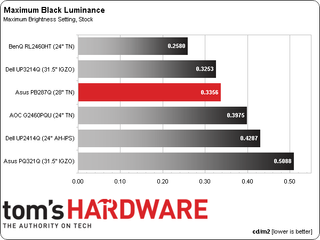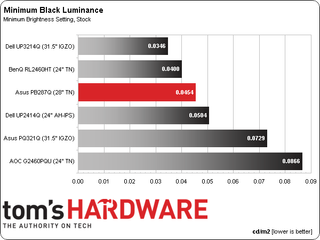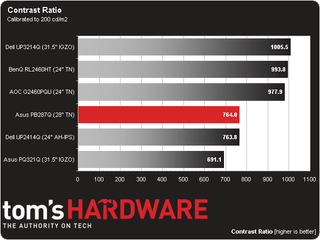Asus PB287Q 28-Inch 4K Monitor Review: Ultra HD For $650
We've seen plenty of buzz about the beauty of gaming at 3840x2160. Up until now, though, that meant spending several grand on a 4K monitor. Asus drives the price down to $650 with its 28-inch PB287Q. But are there sacrifices made in the process?
Results: Brightness And Contrast
Uncalibrated
Before calibrating any panel, we measure zero and 100-percent signals at both ends of the brightness control range. This shows us how contrast is affected at the extremes of a monitor's luminance capability. We do not increase the contrast control past the clipping point. While that would increase a monitor’s light output, the brightest signal levels wouldn't be visible, resulting in crushed highlight detail. Our numbers show the maximum light level possible with no clipping of the signal.
For the comparison group, we’re including the other three 4K screens from Dell and Asus reviewed recently, along with two TN displays, AOC’s 144 Hz G2460PQU and BenQ’s 60 Hz RL2460HT.

We hoped to see greater light output from the PB287Q, since it’s a TN panel, but it proved to be less bright than the IPS-based 4K competition. Although gaming is probably this screen's target market, a little more light would be welcome.

The maximum black level result is mid-pack among both the group as a whole and the three TN screens. The best result in our comparison group comes from BenQ's RL2460HT. However, none of the six monitors on our chart can match the .0121 cd/m2 result posted by Asus’ VG248QE gaming monitor.

Maximum contrast comes in at a little under 1000 to 1. That's not a great result for a TN display, though it does beat a couple of other 4K screens.
We believe 50 cd/m2 is a practical minimum standard for screen brightness. Any lower and you risk eyestrain and fatigue. The PB287Q bottoms out at 39.8748 cd/m2, which is a little low for playing games in a dark room. A few clicks of the Brightness control should improve the image to a more usable state.

The above result again puts Asus' PB287Q mid-pack. It looks like some of the inherent black level advantage of TN is lost at 3840x2160. Among competing gaming monitors, however, it’s still a good choice for contrast.
Stay on the Cutting Edge
Join the experts who read Tom's Hardware for the inside track on enthusiast PC tech news — and have for over 25 years. We'll send breaking news and in-depth reviews of CPUs, GPUs, AI, maker hardware and more straight to your inbox.

When the final contrast numbers are calculated, Asus' PB287Q appears as the lowest TN-based screen in the group. It does, however, compare quite favorably with the other Ultra HD monitors. Remember that this display is much less expensive than the 4K competition, and it still offers comparable contrast performance.
After Calibration
Since we consider 200 cd/m2 to be an ideal point for peak output, we calibrate all of our test monitors to that value. In a room with some ambient light (like an office), this brightness level provides a sharp, punchy image with maximum detail and minimum eye fatigue. On many monitors it’s also the sweet spot for gamma and grayscale tracking, which we'll look at on the next page. In a darker room, some enthusiasts prefer a 120 cd/m2 calibration. It makes little to no difference on the calibrated black level and contrast measurements, though.

The calibrated black level is about average and doesn’t really rise due to the adjustments we made. It is the lowest of the three TN displays in our chart, though.

The final calibrated ratio is lower because we had to drop the PB287Q’s Contrast control in pursuit of better grayscale accuracy. If you’re willing to compromise a little on the 100-percent white point, raise the slider to 90 and it gets closer to 900 to 1.
ANSI Contrast Ratio
Another important measure of contrast is ANSI. To perform our test, a checkerboard pattern of sixteen zero and 100-percent squares is measured, giving us a somewhat more real-world metric than on/off measurements because it evaluates a display’s ability to simultaneously maintain both low black and full white levels, further factoring in screen uniformity. The average of the eight full-white measurements is divided by the average of the eight full-black measurements to arrive at the ANSI result.

ANSI contrast is lower than we expected, considering the PB287Q is a TN panel. While 781.8 isn’t a bad result, it isn’t as high as the other two TN-based monitors, nor does it beat Dell's UP3214Q 4K screen.
The conclusion we draw from our luminance tests is that the PB287Q offers comparable contrast performance as other Ultra HD products. Its unique status as a TN-based 4K display doesn’t improve that metric like we thought it might. At least for now, it looks like going with the highest resolution available means giving up a little contrast.
Current page: Results: Brightness And Contrast
Prev Page Measurement And Calibration Methodology: How We Test Next Page Results: Grayscale Tracking And Gamma Response
Christian Eberle is a Contributing Editor for Tom's Hardware US. He's a veteran reviewer of A/V equipment, specializing in monitors. Christian began his obsession with tech when he built his first PC in 1991, a 286 running DOS 3.0 at a blazing 12MHz. In 2006, he undertook training from the Imaging Science Foundation in video calibration and testing and thus started a passion for precise imaging that persists to this day. He is also a professional musician with a degree from the New England Conservatory as a classical bassoonist which he used to good effect as a performer with the West Point Army Band from 1987 to 2013. He enjoys watching movies and listening to high-end audio in his custom-built home theater and can be seen riding trails near his home on a race-ready ICE VTX recumbent trike. Christian enjoys the endless summer in Florida where he lives with his wife and Chihuahua and plays with orchestras around the state.
-
petar - We need to see Article comparing IGZO - PLS - AHVA panels at first place.Reply
- What happened with AHVA panels M270QAN01.0 , M270QAN01.1 , M320QAN01.0 ,M320QAN01.1 from AUO that were planed for 2014 production ? We are in September 2014 now and no one offers them.
It would be good to know who uses which panel, we have ASUS, Iiyama, AOC, DELL, Viewsonic, Samsung selling 4K displays all based on TN... -
JJussi I would like to see compare to AOC U2868PQU 4K display.Reply
There is not so many "cheap" 4K monitors on market and I would like to choose best for myself...
What I know, there is two other products too:
Philips Brilliance 288P
Samsung U28D590D
Most Popular

